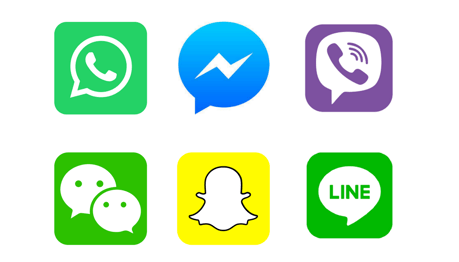Every year HubSpot releases its State of Inbound Report, full of the latest insights into sales and marketing trends. Surveying over 6,000 marketers and salespeople globally, the report highlights the top marketing and sales challenges and priorities businesses are facing. This year's report flagged the rise of messenger apps and how these apps are changing the way people are communicating.

The increased adoption of messaging apps
When asked what content distribution channels marketers plan to add to their marketing efforts in the next 12 months, 24% of survey respondents indicated messaging apps – a 4% rise from 2016. Businesses are now using apps like WhatsApp, Facebook Messenger, Snapchat and WeChat as part of their core business communications.
As with any social channel, as features rapidly update and change, businesses are looking at how they should change their content marketing strategy to reach out to target audiences.
Messenger apps are now being used to not only chat with people, but also to connect with brands, watch content and browse merchandise. One survey respondent highlighted the expansive ecosystem that WeChat offers:
Look at WeChat and how it manages to retain its users within the apps for multiple purposes throughout the day: messaging, news feed, information about companies and products (to a much more thorough degree than what Facebook provides), and payment.
Facebook Messenger and WhatsApp are also regularly adding new features, so we can expect to see more businesses adopting a messaging service to suit their business needs.
Internal communication
When asked how people like to communicate, specifically for official business purposes, 31% of respondents indicated that messaging apps are now an ingrained part of business life. While email, face-to-face and phone communication were still the clear preferred methods of communication, the more "personal" channels such as social media and messaging apps have crossed over into people's business lives.
Interestingly, C-level executives (CEO, CMO) are the biggest users (compared to VP/Directors, Managers and Individual contributors), with 44% preferring to communicate via social media and 37% on messaging apps. The report suggests this indicates senior leaders are more keen to try and test new technologies, especially those considered the next big thing. Messaging apps and social media also allow quick and informal communication – features that are important to people who are on-the-go and in a position to dictate requests.
We can expect to see wider adoption of messaging apps for internal staff communication in the future.
External communication
It's also expected that messaging apps will be widely adopted as a way to communicate with customers. The next phase of messaging app growth will focus on building out services and monetising the massive user base.
As messaging companies build out their services, just as we have seen with WeChat, there will be an increased opportunity to reach out to customers by connecting brands and advertisers with users.
Facebook Messenger have clear plans to expand functionality beyond simple peer-to-peer communication. Its integration of car ride services Uber and Lyft highlight a move towards building a broad range of partnerships. WhatsApp are headed in the same direction with plans to introduce a new commercial messaging platform specifically for businesses.
Messaging app use expected to grow
The report highlights that year over year, there has been slight decreases in people's preference to communicate on nearly all channels except messaging apps. This was the only channel to grow, from 29% in 2016 to 31% in 2017.
The reality is that the combined user base of the top four messaging apps is larger than the combined user base of the top four social networks. This is expected to continue to increase – the projected growth is 2 billion people using messaging apps by 2018. With the uptake of smart phones and tablets, messaging platforms are increasingly becoming the preferred method of communication for our very mobile population.
It will be very interesting to see how businesses adopt messaging apps over the next 12 months, and the impact this will have on other communication channels. If your business is not using any messenger apps, it's definitely worth exploring how they could be incorporated into your marketing efforts, especially considering most apps are now expanding functionality to connect brands with users.
Read the full report below:
Tags:
Marketing + Automation
May 17, 2017

